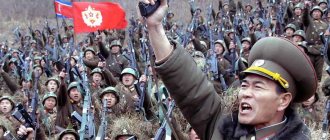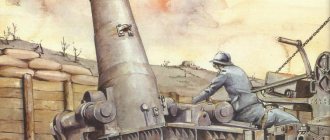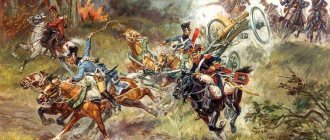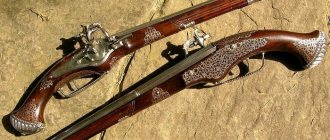History of the French Army
Everything changed at the beginning of the 19th century. It was then that Napoleon Bonaparte came to power. One day, he passed by one of the patrol posts.
Noticing that the duty officer was sleeping, he calmly took his weapon and continued his watch for him. When it was time to change the guard on duty, another soldier saw Napoleon standing guard.
This incident proved Bonaparte's loyalty. Since that time, the French army has become a single force, ready to stand up for its commander-in-chief at any moment.
How non-Marines became “Marines”
With the advent of decolonization, it was no longer very polite to call troops “colonial.” In 1958, they were renamed Troupes d'Outre-Mer - "overseas troops", or "troops of distant seas". But in 1960 it was decided to return the historical name - Troupes de marine.
France retained enormous influence in its former colonies. Therefore, the tasks of yesterday's colonial troops remained approximately the same.
Since Soviet times, in military publications in Russian, such troops have been called marine troops.
In order not to be confused with naval fusiliers and to emphasize that they have no more to do with Marine tasks than tankers from the 5th Cuirassiers have to do with attacks in mounted formation on infantry squares bristling with bayonets.
However, Troupes de marine sometimes actually participate in beach landing exercises with the US Marine Corps. However, in reality, the most typical maritime task of marinas is to climb aboard the Mistral and, while enjoying a Chablis with brie cheese or coffee with croissants, get on it to the friendly port closest to the theater of operations.
In the event of a landing on an enemy shore, Troupes de marine in any normal situation will only follow the marines, that is, the fusiliers.
Uniforms and ranks in the army
A characteristic feature of the French army are epaulets . These are special signs that indicate military rank. Today, few people use them. But in France they have not lost their importance.
Military academies introduced epaulets as their basic uniform. They are also used in parades.
Another interesting attribute is the sash . This is a belt made of fabric, lace or rope that is knitted around the waist. Its main significance is maintaining a neat military appearance. The sash holds the pants tightly and prevents outerwear from falling open.
Belts are made in different colors and sizes. This helps separate the shelves. The entire uniform of the modern French army consists of many traditional details.
Most of them have never been used in other countries.
Among the ranks we can mention Admiral of France . This is the highest military rank in France. Although recently it has not been assigned.
From him came the title Marshal of France . Next up is Army General . This rank applies to divisional generals who, for example, hold the position of Chief of Army Staff. They have five stars on their shoulder straps.
Another unique title is Chief Marshal of France . He can also be called Generalissimo . If there can be several Marshals of France at once, then this post can only be held by one person.
Heirs of Napoleon: the army of the Restoration
In France, the 19th century is often counted from 1815, when power, as Chateaubriand put it, passed from giants to pygmies. Indeed, the subsequent decades of the French army seemed to be in the shadow of the monumental achievements of Napoleon and his soldiers. In the pages of Warspot we will tell this half-forgotten story, full of both brilliant victories and humiliating defeats, and we will begin with the army of the Bourbons, who ruled France for the first fifteen years after the final overthrow of the “little corporal”.
Lucien Leven, the young son of a banker from Stendhal's novel of the same name, was forced to join the Uhlan regiment in the early 1830s. The cornet's thoughts immediately turned to battles, dashing attacks and the love of the charming peasant women who inhabited the countries east of the Rhine. At the same time, Lucien knew how to combine ambitious dreams and common sense, and his thoughts quickly took a different turn:
“But no […] I will only fight with cigars; I will become one of the honorary regulars of a military cafe in a sad garrison of a poorly paved town; as evening entertainment I will have several games of billiards and a few bottles of beer and sometimes in the morning an empty argument with dirty, starving workers... At best, I will be killed, like Pyrrhus, by a chamber pot (an unpleasant surprise!) thrown from the window sixth floor by a toothless old woman. What glory! My soul will be in a rather absurd position when in the next world I am presented to Napoleon. “Without a doubt,” he will say, “you were dying of hunger since you took up this craft?” - “No, general, I thought I was imitating you.”
We will return to Lucien later, but for now we will point out that in this small fragment, as if in a drop of water, many plots of the military history of France after 1815 were reflected. The French army lived with memories of the glory of the Napoleonic era, but was forced to fight mainly with boredom and its own population, which constantly threatened to rebel (we will leave the difficult war in Algeria out of the picture for now). After the humiliating defeat in the Franco-Prussian War of 1870-1871, many believed that the roots of the disaster that befell the French lay hidden in this atmosphere of complacency. However, before 1870, an unbiased European would probably have recognized that the French army was the first in Europe. Let's try to find out which of these views is more accurate, starting this story from the first post-Napoleonic days.
Restoration
The successive change of five political regimes largely determined the history of the French army in 1815-1914, and the first of them was the Restoration, that is, the return to power of the Bourbon dynasty: first Louis XVIII (1815-1824), and then Charles X (1824-1830) . When Napoleon’s “hundred days” ended, and the first of them firmly established himself on the throne, France was in a deplorable state: the country was occupied by the victors who needed to pay indemnities, white terror was raging in the provinces, and finally, the officer corps split into political factions.
A.-I. Melling. Entry of King Louis XVIII into Paris on May 3, 1814, as he crosses the Pont Neuf histoire-image.org
A new French army was born out of chaos, and its embryo was to be the royal guard and departmental legions. The first replaced the Napoleonic guard and was supposed to become a reliable support for the throne, and the second were intended to suppress the corporate spirit of the old regiments. The legions were recruited on a voluntary basis, and many of them existed only on paper or numbered less than 500 people. Marshal J. Macdonald, who switched to the Bourbon side in time and, more importantly, remained loyal to them during the “Hundred Days,” tried to keep the tricolor in the troops, but the Bourbons were adamant. The army received white banners, and with them the unpleasant nickname les culs blancs
(“white-bottomed”).
Cleaning
The worst was yet to come. The Napoleonic wars left behind a huge number of officers, to whom were added aristocrats returning from emigration and wanting posts. For example, the Duke of Cars received the rank of colonel at the age of 23, having only served briefly in the English army. There were 446 marshals and generals alone, but the army then consisted of only 75,000 people. It was clear that someone would have to leave the service. 12,000 officers were put on half-pay, and many more were dismissed due to age, injury, or illness. The competition for the few places was aggravated by the fact that the time had come to settle political scores, and in 1817 a special commission began work that examined the behavior of the officers who served the “usurper.”
J.-L. Jerome. The Death of Marshal Ney (1868) useum.org
Back in 1815, by order of the House of Peers, Marshal Ney was shot. General Drouet d'Erlon was sentenced to death, but he had already left for Bavaria and opened his own pub in Munich. Lefebvre-Denuette and the Lallemand brothers fled to the United States. Europe, America and even Egypt were literally flooded with fugitives with a Napoleonic past. The rest had to go through a commission and end up in one of 14 categories, which included deportation, house arrest, resignation, half pay, etc. Many people who were the flower of Napoleonic France were expelled from the country: Soult, Vandamme, Rapp, Savary, Lamarck, Clausel and others. The former ambassador to St. Petersburg, A. de Caulaincourt, avoided deportation only thanks to the intercession of Alexander I. Marshal Davout escaped with house arrest. Marshal Serurier was dismissed - perhaps his advanced years and his vote for Ney's execution played a role. As a result, France was left with approximately 5,000 officers on active service, as well as 20,000 no longer serving—three-quarters of them receiving half pay.
The purges resulted in the French army being a layer cake of former emigrants and Bonapartists. The average picture looked like this: the colonel was a loyal royalist, forced to turn to a lieutenant colonel from among Napoleonic veterans for help; the captains were most often old soldiers of the Empire, and the subaltern officers were either young aristocrats or already seasoned comrades of the Corsican. Napoleonic veterans, left behind the army, looked with hatred at the royalist officers, many of whom did not smell gunpowder. "Noble" officers and "commoners" dined at separate tables and sat in separate pews in the church. One of the officers said that in his regiment there was a captain who fought for 25 years against the revolution and Bonaparte in the ranks of foreign armies, and his battalion commander hid the imperial eagle under Bourbon lilies on his shako. Duels became as commonplace as in the time of d'Artagnan. In Stendhal's novel, Lucien Levene had to fight with swords to refute the (quite correct) opinion that he was a republican.
Fusilier's shako of the 31st Line Infantry, model 1822 pinterest.com
Saint-Cyr's Law
Since 1798, France has had a conscription, that is, compulsory military service for all classes. The 12th paragraph of the constitutional charter of 1814, imposed on Louis XVIII by the allies, stated that this order, hated by the population, was abolished. But by 1818, France was able to pay the indemnity and regain its subjectivity in international relations - now the question arose of how to reinforce the country’s returning high position.
The new French army had to be small in size, and it was not only financial considerations that dictated this choice. Conceptions weighed heavily on the population, and among the ruling classes they were strongly associated with the republican spirit. Chateaubriand exclaimed: “How can a monarchical government combine a method of recruitment leading to democracy, since it is based on the principle of equality?”
Many Frenchmen remembered that Napoleon won his most brilliant victories with a small army, and when it grew to enormous size, as during the Russian campaign of 1812, his star began to set. This confirmed the old dogma that there is a certain limit to the number of troops, after which quantity ceases to turn into quality due to the difficulties of management, organizing marches and supply. Many soldiers preferred a compact army of professionals to huge crowds of recruits.
O. Vernet. Future Marshal Gouvion-Saint-Cyr at the Battle of Pułtusk (1821) art.com
Laurent Gouvion-Saint-Cyr, Marshal of France and Minister of War of Louis XVIII, viewed the matter in approximately the same way. The Saint-Cyr Law of March 10, 1818 laid the foundation for the future army. The first paragraph tried to reconcile the dream of a professional army with reality: “The army is recruited on a voluntary basis and, if necessary, by conscription...”
The word “conscription” was carefully avoided so as not to violate the charter, but in essence that is what it was. All young people, regardless of origin, upon reaching 20 years old, drew lots, and if they got a “bad number”, then for six years they fell under the banner, and then for another six years they were considered “veterans” who could be called up in case of war . If the conscript had the appropriate financial capabilities, he could nominate a replacement in his place.
Practice quickly corrected these provisions. Due to vacations, service was reduced to 4-5 years, and after the Spanish Campaign of 1823, when the government became convinced of the impossibility of conscripting veterans, this reserve was abolished and the period of active service was increased to 8 years. As a result, the French army actually lost the ability to call up additional contingents, although General Moran already wrote in his book “On the Army According to the Charter” ( De l´Armée selon la Charte,
1829) proposed to solve this problem. Generals Foy and Lamarck, who had a strong reputation as liberals, advocated increasing the national guard, but it was always perceived as a last reserve in case the active army could not cope. They decided to leave the problem of reserves until better times.
On paper, the Saint-Cyr system looked harmonious and logical. The French army consisted of 240,000 soldiers (for comparison, the Prussian - 130,000, the English - 140,000, the Austrian - 273,000, the Russian - 826,000) and consisted of six ages of 40,000 people. The last figure was the annual recruitment contingent. Such an army was relatively inexpensive, and French military spending did not exceed a third of the budget. The eight-year service period meant that the connection between the army and the civilian population, which had previously been rather illusory, was practically severed. After finishing their service, soldiers preferred to remain in it as long-term conscripts, and the French army became increasingly professional and isolated from society.
Officer Corps
From the ultra-royalist point of view, the appointment of officers was the prerogative of the king, but from the point of view of everyone else it led to the scandalous favoritism that characterized the Ancien Regime and the period 1814-1815. Based on this, Saint-Cyr wanted to make clear rules on this issue and, if possible, limit the power of the monarch over the careers of officers. Clause VI of his 1818 law stated that no one was eligible to become an officer without serving two years as a non-commissioned officer or going through military school. At least a third of the vacancies for junior lieutenants ( sous-lieutenant
, the most junior officer rank) should be given to non-commissioned officers.
Promotions are to be made two-thirds by seniority, and only one-third by the king's choice for ranks up to and lieutenant-colonel
.
The further path in the hierarchy was determined only by the choice of the king, but in general his rights were significantly limited. In addition, Saint-Cyr returned some of Napoleonic officers to service and managed to get rid of the most quarrelsome emigrants. As R. Holroyd wrote, “under Gouvion-Saint-Cyr, destruction gave way to reconstruction, for which the law on recruitment and the ordinance on ranks provided an excellent basis
.
Royal Musketeer pinterset.com
As a result, two castes were formed in the French officer corps: students of military schools, who had either noble or bourgeois origin, and former non-commissioned officers, as a rule, from poor backgrounds. For the beginning of the 19th century, this was a rather original system, since among large countries, only in Russia did non-commissioned officers have a chance to receive epaulettes. In France, the principle of “a marshal's baton in every soldier's knapsack” was much closer to realization than in the Romanov Empire, and in each generation of soldiers there were outstanding military leaders who began their service as ordinary soldiers. As often happened with the French army, practice adjusted the norms of the laws. Saint-Cyr guaranteed a third of the vacancies for non-commissioned officers, but in 1825 50% of new recruits were soldiers, and under subsequent regimes this proportion rose to two-thirds. In the same year, 1825, the old nobility received only 24% of officer promotions, and the Napoleonic nobility received 3%.
The French army became the most democratic in Europe, which was both its strength and weakness. Approximately 5% of enlisted officers reached the rank of lieutenant colonel and colonel, and 3% became generals. Most ended their careers with the rank of captain. People from the lower ranks almost always knew the service down to the subtleties, and were often distinguished by their attention to the needs of the soldiers, but their outlook left much to be desired, and this was critically important at the high levels of the military hierarchy. Many contemporaries noted the kind and somewhat familiar relationship between soldiers and officers, but the French army lacked a strong non-commissioned officer corps, as good non-commissioned officers were quickly promoted to junior lieutenant. In addition, non-commissioned officers sometimes deliberately “framed” their superiors in order to open a vacancy for themselves. The officer corps was filled with a specific type of people, whose cultural level was much inferior to their foreign colleagues and often distinguished by completely unnoble behavior.
Upon joining the Lancers regiment, Lucien Levene encountered this type of officer. The commander of his regiment, Lieutenant Colonel Toner Filoteau, was born a simple peasant, received epaulettes back in Egypt (1798-1799), participated in the battles of Marengo (1800) and Austerlitz (1805), but Lucien found in him not a hero, but a rude scoundrel who earned the Order of Honor legion not for exploits, but for the fact that he quickly forgot the words of “Marseillaise” and during the Restoration he was the first of the officers to go to communion. Philoteau's interests revolved around drink and money, and he immediately began to calculate the benefits that he would derive from the addition of the son of Monsieur Leuven, one of the richest Parisian bankers, to his regiment.
Unknown artist. Portrait of the Royal Musketeer of the 1st Company (1815) musee-armee.fr
French Decembrists
Louis XVIII tried to become the king of all French, but when the heir to the throne, the Duke of Berry, was assassinated in 1820, and revolutions broke out in southern Europe, he began to lean toward outright reaction. Liberals responded to this by creating secret societies in which officers took an active part. The king and the royalists suspected that "beneath the beautiful white uniforms beat Bonapartist hearts"
(expression of one of his contemporaries). In 1821, the Prussian ambassador described this situation as follows:
“The king cannot count on any of the regiments of his army due to the war of opinions. Even if the Spaniards unfurl the tricolor in the middle of France, it will be enough to start a civil war there and overthrow the government.”
Soon these gloomy forecasts were confirmed. At the end of 1821, a conspiracy was discovered at the Saumur military school, after which secret societies began to be discovered almost every month. A series of executions followed, which extinguished the wave of the revolutionary movement. Napoleonic veteran O.-J. Caron, one of the conspirators captured in Colmar, was tried by a military tribunal, although he had already left the service. The case was scandalous, and even ten years later Lucien Levene shuddered when he learned that one of his interlocutors held an important position in Colmar in the early 1820s. The memory of Caron lived in the hearts of liberals for many years.
O.-J. Caron, 1850 biblio.bnu.fr
The situation in France in the 1820s was largely consistent with pan-European trends emerging in Spain, Portugal, Italy and Russia: young liberal-minded officers planned to overthrow despotism in their countries in the name of freedom and the constitution. The specificity of the French case was given by the hatred that the young officers had for their emigrant commanders, and the feeling of alienation from their comrades who had reconciled with the Bourbons. These feelings were fully shared by the aging heroes of the Napoleonic wars, who were retired on half pay.
However, the power of this movement should not be exaggerated. The army remained more loyal than it was thought, and often squeezed out the dissatisfied and restless element, and the conspirators were never strong or decisive enough to create serious problems. In 1823, the French army, not without hesitation, invaded Spain to suppress the revolution there. This did not cause an uprising in the French units - the soldiers surprisingly easily fulfilled their legitimist duty. Moreover, the commander-in-chief, the Duke of Angoulême, took with him many Bonapartists: these people had experience and did not cause problems. The Duke burned the denunciations drawn up by the officers against each other, assigned the most suspicious regiment to his personal convoy and marched the army through the Pyrenees. When 150 people in the uniform of the Napoleonic Guard appeared in front of the Duke and began waving the tricolor to their compatriots, they were scattered by a volley of grapeshot. The new French army was tested not only for combat effectiveness, but also for political loyalty. In addition, the Spanish campaign made it possible to temporarily forget and partially smooth out the political squabbles that tore apart the officers' environment. The Spanish campaign was perceived as a military duty, and only serious problems with supplies - a formidable harbinger of future troubles - overshadowed its execution.
A.-J.-B. Tom. Louis XVIII receives the Duke of Angoulême after returning from the Spanish War on December 2, 1823 chateauversailles.fr
In 1824, Louis XVIII died. The transfer of power to Charles X took place calmly: nothing similar to the Decembrist uprising that broke out a year later in Russia happened in France. Perhaps it was the “crusade” against the Spanish revolution that extended the life of the Bourbon regime for several years. Charles X wanted to more firmly link the army not only with the ruling dynasty, but also with religion - military chaplains appeared in the regiments, who often served as political spies. The military began to be more persistently forced to attend church services and perform the necessary rituals: baptism, communion, confession, etc. The depth of Christian feeling began to influence career growth. Many army men were irritated by the imposition of religion, but in 1830 the Restoration regime was swept away as a result of an urban uprising, and not a military conspiracy.
Sh.-A. Chassla. The burial of His Majesty Louis XVIII in the royal church of Saint-Denis on September 24, 1824 (detail) chateauversailles.fr
In 1815-1830, the Saint-Cyr Law and other measures laid the foundation for a new French army with all its distinctive features. France now had a small, virtually professional army, recruited through voting with the ability to provide replacements. As R. Holroyd wrote, “it was a royal, not a national army, much like the Prussian army that Napoleon defeated in 1807, a separate organism that had little in common with the nation as a whole.”
. Its officer corps was accessible to the common man, and, having received epaulettes, he entered into competition for ranks with wealthier or more noble comrades who had graduated from military schools. The Bourbons failed to achieve homogeneity in the officer corps, and it was divided into groups based on social origin and political views. The latter predetermined the enormous dependence of the army on the new political cataclysms that awaited France in the 19th century, and these cataclysms, in turn, strongly depended on what position the army would take.
To be continued
Literature:
- Stendhal. Lucien Levene // https://az.lib.ru/s/stendalx/text_0020.shtml
- Histoire Militaire de la France. Sous la direction d'André Corvisier. 2 – De 1715 à 1871. (Presses Univeritaires de France, 1992)
- Griffith, P. Military thought in the French army, 1815-51. (Manchester Univ. Press, Manchester and NY, 1989)
- Bury, JPT France, 1814-1940. (Routledge, London & NY, 2003)
- Lavisse E., Rambo A. History of the 19th century. T. III. M., 1938-1939
- Serman, W. La noblesse dans l'armée française au XIXe siècle (1814-1890) // Les noblesses européennes au XIXe siècle. Actes du colloque de Rome, 21-23 November 1985. (Rome: École Française de Rome, 1988). pp. 551-558
- Holroyd, R. The Bourbon Army, 1815-1830 // The Historical Journal Vol. 14, No. 3 (Sep., 1971), pp. 529-552
- Kennedy, P. The Rise and Fall of the Great Powers. Economic Change and Military Conflict from 1500 to 2000. (FontanaPress, 1989)
Military parades
Parades are always an amazing sight. At such moments, you realize the full power of your native country much better. France is famous for its military parades.
Military parade on Bastille Day
From the colorful uniforms, rich in their traditional attributes, to the display of military equipment and its power, France shows strength and majesty to its people.
All types of troops perform at the parade. The ground forces come out first. Their march fills the entire square, so it is impossible to tear yourself away from this procession.
Next come different types of military equipment. The highlight of every parade is the air force. When several professional military fighter jets appear in the sky, all the citizens applaud in delight.
Despite its calm state, it continues to develop military equipment and weapons. French parades only confirm the importance of military affairs for this state.
How Marines Became Not Marines
In France, special troops intended for foreign operations are traditionally called naval. They appeared in 1622 as a classic marine corps at the behest of Cardinal Richelieu. This great statesman created the regular French fleet. Well, what is a fleet without marines?
Over time, it turned out that most of these marines boarded ships only for transportation across the seas and oceans. And their main task was garrison service in the French overseas possessions and the expansion of these possessions with a bayonet and a cannonball.
Since 1831, the Infanterie de Marine, or Marine Corps, ceased serving on ships and received weapons and uniforms modeled on the ground forces.
The French first assigned the role of marines to naval crews, and in 1856 they created Fusiliers Marins - naval fusiliers. This is what real French Marines are called to this day.
It is they who, in the first wave of landings, go to a hostile shore, commit reconnaissance and sabotage outrages on this shore, and other things inherent in the marines of other countries.
Well, our heroes in 1890 finally broke all ties with the naval department and from 1900 received a more precise name - Troupes Coloniales or “colonial troops”.
Note that the colonials did not expand French possessions in North Africa: Algeria, Morocco and Tunisia. This was done by the French Army of Africa, from which the Legion grew, as well as exotics like tirailleurs, spagi and zouaves.
Colonial troops were employed in Trans-Saharan Africa and the Asian colonies of Paris. It was these lands that they annexed to the French empire with fire, sword and croissant. However, the colonials took part in all major European wars. Each Troupes Coloniales regiment has a long list of battles in which its men fought.
The most significant battle for them was the Battle of Bazeilles on September 1, 1870, in which they fiercely resisted the German troops of Bismarck.
Armored vehicles of military conflicts in Africa
The most “popular” armored vehicles of these conflicts were the AMX-13 tank and Panhard AML gun vehicles of various modifications, which were modernized in African countries. Tanks, self-propelled guns, armored personnel carriers and armored vehicles of all warring parties are presented in the following halls of the Museum of Armored Vehicles in Saumur.
- Post-war France (AMX-13...)
- Fighting France (French and British equipment)
- Warsaw Pact (Soviet tanks T-34, T-54, T-62, etc.)
- Modern World (NATO armored vehicles)
Deus Vult, Battle Hedgehogs and Red Star Colonial Commandos
The Marine motto is the phrase “Et au Nom de Dieu, vive la coloniale!” - that is, “In the name of God, long live the colonial troops!”
The phrase only looks pretentious and similar to Deus Vult (“This is what God wants” - the battle cry of Christians during the proclamation of the first crusade). The story of its origin is simple and ironic.
Once upon a time there lived a French missionary, Charles Eugene de Foucauld, among the Tuareg tribes in the middle of the Sahara. He studied the Tuaregs and at the same time tried to convert them to Catholicism.
Charles de Foucault
Naturally, not everyone liked it. In 1908, his mission was besieged by groups of disgruntled tribes. The poor guy was completely desperate, but a company of colonial troops came to his aid.
When de Foucault saw the marching column of Troupes Coloniales fighters, the future blessed of the Catholic Church fell to his knees, raised his hands to heaven and uttered that very phrase. The colonials really liked it.
The symbols of the units and divisions of the marines are a separate story.
Emblems of the 2nd Marine Infantry Regiment and badge of the 5th Company
For example, the emblem of the 2nd Infantry Regiment Troupes de marine features a romantic sailboat with fleur-de-lis. And on the badge of his 5th company we are surprised to find a stern military... hedgehog. In a uniform dark blue cap with an anchor. Moreover, the nickname of the soldiers of the fifth company is elephants. L - logic!
However, when the Second Marine Infantry Regiment was still the second colonial infantry regiment, its emblem was no less impressive. It depicted a cheerful white brontosaurus against the background of an anchor and the Lorraine cross.
Marinas are especially fond of Asian exotica, which is not surprising given their track record in Indochina.
Emblems of the 2nd squadron of the 1st infantry regiment, the control and logistics squadron and the reconnaissance and fire support company of the 2nd regiment
The emblem of the 2nd Squadron of the 1st Marine Infantry Regiment (which is actually armored cavalry - traditional names, yes!) is a perplexed eastern dragon with a feathered sabot shell in its paws. Their colleagues from the control and logistics squadron have the Indian seven-headed serpent Vasuki, a companion of the god Shiva. The reconnaissance and fire support company of the 2nd regiment has a black dragon with lightning in the background of a mortar.
Emblems of the 2nd and 3rd companies of the 3rd regiment
Africa is also on the patches. A brooding camel from the 2nd company of the 3rd regiment and a stubborn-looking lion from the 3rd company of the same regiment.
But the harshest and most cynical of all is the old emblem of the 3rd Marine Parachute Regiment from the times when it was still the 3rd Battalion of Colonial Commandos in Saigon. It depicts an anchor and a parachute. Between the horns of the anchor there is a luxurious red star, and on the stem there are the letters BCCP (“bataillon colonial de commandos parachutistes”). Let me remind you that the battalion fought against the Vietnamese communists at the height of the Cold War. Using the most “Soviet” looking emblem in the history of Western armies.
But the 1st Marine Parachute Regiment, which is part of the French special operations forces, displays the suspiciously familiar letters SAS on its emblem: during the Second World War it appeared as a French-staffed division of the British SAS (SAS, Special Air Service - one of the world's first special forces ), and only then became part of the French armed forces.
French African policy after de Gaulle
In April 1969, President Charles de Gaulle resigned. His Prime Minister Georges Pompidou won the new elections. But France's African policy remained the same. Valéry Giscard d'Estaing, who assumed the presidency after Pompidou's sudden death in 1974, showed determination to solve African problems by military force. He called France a buffer against communist expansion in Africa. President Giscard d'Estaing carried out two of the most famous and successful operations of the French army during the Cold War - in 1978 against the rebel detachments of the "Katangese gendarmes" in the Congolese (Zairean) province of Katanga (Shaba) and in 1979 overthrew the Emperor of the Central African Republic Jean I (Bokassa). In 1981, socialist François Mitterrand became president of France. But the change in French African policy expected by political scientists did not happen. The period of François Mitterrand's presidency (1981-1995) was full of military operations in Africa. Mitterrand sent troops to Rwanda three times, Chad and Zaire twice each, and Gabon once. French troops took part in the UN intervention in Somalia from 1992-1995. Pierre Mesmer, the former Minister of the Armies, even once called Mitterrand “a maniac of military gestures in Africa.” In 1995, hardliner Jacques Chirac became President of France. It is noteworthy that Chirac again appointed Jacques Foccart as his adviser on African affairs! And when Foccart died on March 19, 1997, many assumed that the end of the Françafrique era had come. And the military-political situation in Africa had by this time undergone a serious transformation, since the Cold War had ended. The leading powers ended the confrontation in Africa, leaving the former vassals to decide their own fate. And this has sharply increased the number and scale of armed conflicts here. And Paris began to get tired of the role of “African firefighter” that had been taken upon itself. The spark that catalyzed this fatigue was the Rwandan civil war of 1990-1994. And the participation of the French army in the pacification of Rwanda was subjected to severe criticism throughout the world.
Return to interventionist policies in Africa
On September 19, 2002, another military rebellion broke out in Côte d'Ivoire. Immediately after it began, the French President ordered military intervention in this country. The speed of the decision was explained by the fact that Jacques Chirac had a free hand: Prime Minister Lionel Jospin imprudently ran for the 2002 presidential elections and lost them, after which he left politics altogether. The core of Nicolas Sarkozy's (2007-2012) election campaign in 2007 was a declared “break” with previous policies. Sarkozy argued that the post-colonial era in Africa was over, and French politics was no longer determined by shadowy informal connections. However, faced with reality, Sarkozy quickly changed his views. In 2008 in Cape Town, in his speech he outlined the reform of relations with African states. France, as before, was responsible for controlling the security system in France, but at the same time intended to share the military burden with the countries of the European Union. But in practice, it turned out that Nicolas Sarkozy completely returned to his previous interventionist African policy. One Western diplomat, who worked in Africa for a long time, once noted that Sarkozy wants to return France to the status of “gendarme of Africa,” and not only its Francophone part. And there are certain grounds for such a statement. In particular, France's intervention in the civil war in Libya on the side of the rebel forces (Operation Harmattan) began immediately after the adoption of UN Security Council Resolution No. 1973 of March 19, 2011. French combat aircraft attacked the positions of Libyan government forces. The adoption of such a hasty decision, among other things, was clearly influenced by the long-term Franco-Libyan confrontation in Chad, and by Tripoli’s previous active attempts to interfere in the political situation in other parts of Francophone Africa. True, the French had to face the dismal results of their victory in Libya just a year later in Mali - in the zone of their direct interests.









